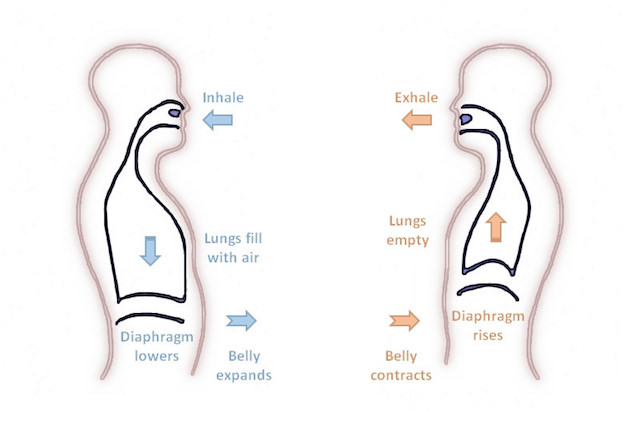
A yogi measures his or her life in terms of breaths, not days.
Prana means breath, wind, life, vitality, energy, or strength. Ayama means length, expansion, stretching, or restraint. Thus, pranayama is the extension and control of the breath.
Pranayama is both a powerful tool and an end in itself. Through the proper use of the breath, a yogi can rid the physical body of toxins, increase vital energy, relax and control the body, relieve or prevent cramps, conquer desire, and even bring emotions and the mind itself under control.
Breathing is our most important bodily function that is subject to our direct control. It is also the most neglected, underestimated, and abused. Our body rids itself of more waste products during respiration than it does by sweating, urinating, and defecating combined. Without the constant intake of oxygen from one breath to the next, we would die in a matter of minutes.
Most people view breath in terms of yes/no logic. Either you are breathing (which is good), or you are not breathing (which is bad). Many of us do not realize that the lungs are capable of doing more than just keeping us alive. The path to an early grave is paved with poor breathing habits.
Conversely, conscious and deep breathing can improve the quality and extend the length of our life. Learning to be aware of our breath opens a whole new dimension of consciousness within. Learning to control our breath allows us to control the chemistry of our blood, and thus our body chemistry.
Awareness and control of the breath also enables us to regulate our emotions. And mastery of the breath is vital to spiritual growth.
Our lungs are delicate. There are no nerves in the lung tissue, so when we damage our lungs, there is no signal sent from the lungs to the brain. Hence, the behavior that caused the damage is repeated over and over. One example of damaging behavior is taking too much air into the lungs. If the lungs are expanded fully, and then you expand your chest a little further, drawing in additional air, lung tissue is torn but you feel nothing due to the lack of nerves in the lungs. Repeating this behavior leads to scarring and reduced efficiency of the lungs. Therefore, do not fill your lungs to more than 90 percent capacity, unless you are working with a qualified pranayama teacher.
One thing we can all do to master our breath is practice diaphragmatic breathing:
Lie down on your back (it is easiest to learn while lying down—later you can practice sitting or standing). Place your left hand on your abdomen below the navel and the right hand on your chest. As you breathe, notice whether there is more movement in the abdomen or the chest. The more you use the diaphragm when breathing the more movement you will feel in the abdomen.
Try to take your breath down deeper and deeper into the lungs so that you feel the abdomen lifting as you breathe in and falling as you breathe out. Gradually, each time you practice this, you should notice the abdomen moving more firmly and the chest moving less. If you cannot feel the action of the diaphragm, try sneezing or laughing and you will feel a very pronounced movement of your left hand resting on the abdomen.
As abdominal breathing becomes easier, let your breathing become slower, deeper, smoother, and more wave-like. Relax as much as possible and allow any resistance to dissolve into one smooth, continuous, fluid breath.
This is the technique of breathing that should be used at all times: while at rest, work, or play. Practice until it becomes natural and unconscious.
Here are just a few of the many reasons for using diaphragmatic breath:
>> With each diaphragmatic breath, the abdominal organs are massaged. Day in and day out, they are stimulated and invigorated. This alternating squeezing and relaxing action helps pump the blood through the organs of the abdomen and plays a key role in moving waste through the intestines.
>> The lungs are pear shaped, with the narrow end pointing upward. This means that with chest breathing, only the narrow top part of the lungs are used, rather than the larger, deeper recesses accessed during diaphragmatic breathing.
>> Due to gravity, the lower recesses of your lungs have a richer supply of blood pumping through them, and thus are better suited for efficient exchange of gases during respiration.
>> Less energy is required to breathe with the diaphragm, than with the chest muscles.
>> Shallow chest breathing never empties the waste products from the deep recesses of your lungs where they accumulate and stagnate.
So, whenever possible, breathe from your diaphragm.
~
Relephant:
Best Breath Practices: 5 Energizing Pranayama Techniques.
32 Ways to Pay Attention to Your Breath {Pranayama Preliminaries}
~
Author: Michelle Margaret Fajkus & Charles MacInerney
Image: Remedial Class/Flickr
Editor: Nicole Cameron
Copy Editor: Yoli Ramazzina
~
Charles MacInerney has been at the forefront of the yoga revolution since 1989 as one of the first teachers in the United States to take yoga into the business world, hospitals, government agencies, nursing homes, schools, and universities. Charles co-founded the Texas Yoga Retreat with Ellen Smith, which has brought yoga teachers and students from Texas and beyond together each fall in Austin since 2000. The next Texas Yoga Retreat will be held from October 26-28, 2018. Charles and Ellen have also offered yoga teacher certification through their Living Yoga Program since 1999 and have graduates teaching Yoga in 44 U.S. States and 14 countries. Charles leads retreats in Texas, Massachusetts, and internationally and teaches classes and full moon yoga gatherings regularly in Austin.
 Share on bsky
Share on bsky





Read 1 comment and reply